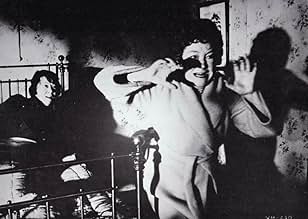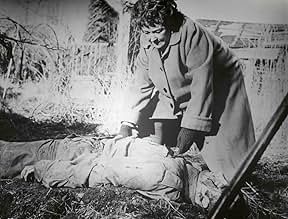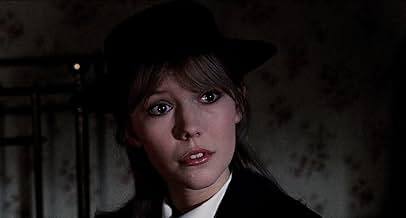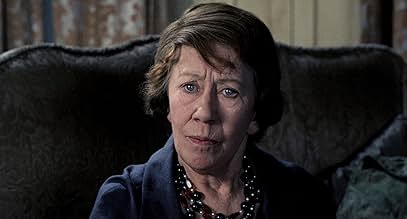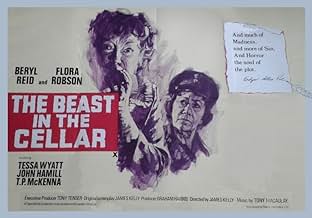AVALIAÇÃO DA IMDb
4,9/10
1,2 mil
SUA AVALIAÇÃO
Adicionar um enredo no seu idiomaSoldiers in a rural English town are being brutally murdered by an unknown creature. Two sisters living nearby realize they might understand what's happening.Soldiers in a rural English town are being brutally murdered by an unknown creature. Two sisters living nearby realize they might understand what's happening.Soldiers in a rural English town are being brutally murdered by an unknown creature. Two sisters living nearby realize they might understand what's happening.
- Direção
- Roteirista
- Artistas
Avaliações em destaque
A soldier walks alone in the ever darkening sunset. Suddenly he is attacked by a creature. You know this because the camera is shaken around, there is disjointed screaming, and the same photo of a bloody slash mark is subliminally flashed. This was obviously to avoid too much editing by the censor, but I immediately thought, "Great, a 1970's crap horror movie. Worth watching" Then the laid back, easy-listening trumpet title tune put the icing on the cake - more cocktail lounge than horror film it is immediately at odds with the theme of the film. After the intro, the usual chapter with the detectives investigating the incident scene. You don't actually see the body, but the contrived commentary by the detectives gives you a good idea of its condition. "Hmmmm, deep lacerations to the face and body made by talons, I'd say." You get the picture. This thorough off the cuff autopsy by the detectives gets them off on the wrong foot by making the assumption that it's a Panther.
Apart perhaps from the two leading actresses and T P McKenna, there is little evidence of any real acting. The soldier that keeps an eye on the two old dears was probably a real soldier - he appeared to be reading from idiot boards such was his woodeness. However, the story does get a bit more involved and at times seems well written, so you shouldn't judge this film by the first amusing half hour.
Apart perhaps from the two leading actresses and T P McKenna, there is little evidence of any real acting. The soldier that keeps an eye on the two old dears was probably a real soldier - he appeared to be reading from idiot boards such was his woodeness. However, the story does get a bit more involved and at times seems well written, so you shouldn't judge this film by the first amusing half hour.
Sometimes a film just captivates your imagination. I first saw The Beast In The Cellar when I recorded it off late-night British TV, in 1992. I've since watched it in it's Odeon DVD incarnation, and it still resonates.
It may not be shocking, surprising or horrific, but I just 'enjoy' this film. The interplay between Beryl Reid, who was only 51 at the time but playing much older, and Flora Robson, represents the ending era of traditional British actresses in traditional British films.
This film has spectacular photography. The credits shot of a crepuscular sunset is unsurpassed, combined with the evocatively non-lyrical theme. It is the best shot of a sunset over British countryside that I have ever seen.
The story is admittedly weak once we find out that the sisters know what they know. However, their resolve to try and keep up their 'secret' is humanistic and done well.
The 'inserts' of gore are very brief and very effectively vivid. I think for once it doesn't harm a film.
The finale of 'the monster' coming up the stairs for the sisters, largely done in 'Nosferatu' style until a last shot, is very creepy.
In short, this isn't a great film, and impatient 'Netflix' viewers will find there's a lot of talk and little 'action'. However, the drama confined to the house between the two sisters is fascinating in itself; uncovering the mystery of the dynamics between them almost becomes the thing to 'solve' rather than the 'Beast' issue.
A film I could watch again and again, albeit leave a few years between each viewing.
It may not be shocking, surprising or horrific, but I just 'enjoy' this film. The interplay between Beryl Reid, who was only 51 at the time but playing much older, and Flora Robson, represents the ending era of traditional British actresses in traditional British films.
This film has spectacular photography. The credits shot of a crepuscular sunset is unsurpassed, combined with the evocatively non-lyrical theme. It is the best shot of a sunset over British countryside that I have ever seen.
The story is admittedly weak once we find out that the sisters know what they know. However, their resolve to try and keep up their 'secret' is humanistic and done well.
The 'inserts' of gore are very brief and very effectively vivid. I think for once it doesn't harm a film.
The finale of 'the monster' coming up the stairs for the sisters, largely done in 'Nosferatu' style until a last shot, is very creepy.
In short, this isn't a great film, and impatient 'Netflix' viewers will find there's a lot of talk and little 'action'. However, the drama confined to the house between the two sisters is fascinating in itself; uncovering the mystery of the dynamics between them almost becomes the thing to 'solve' rather than the 'Beast' issue.
A film I could watch again and again, albeit leave a few years between each viewing.
This was the first title from Anchor Bay UK's "Tigon Collection" Box Set that I checked out - being already familiar with the higher-profile titles among them, namely WITCHFINDER GENERAL (1968) and THE BLOOD ON SATAN'S CLAW (1970). While the film isn't as bad as its reputation would suggest, and is actually well worth watching, it is by no means a classic. The interesting premise classifies it as an anti-war movie but it was deemed to be too talky by executive producer Tony Tenser and, along with some cuts, he ordered the addition of sex and violence inserts to heighten its commercial potential. However, incongruous as they may seem alongside the film's generally deliberate pace, these rapidly-cut scenes of the rampaging 'beast' work quite well!
The film's mainstay, of course, are committed performances by the two elderly female leads - Beryl Reid and Flora Robson - but also T.P. McKenna as the police official investigating the murders. John Hamill and Tessa Wyatt's contribution - intended to provide the requisite romantic interest - is largely negligible, however. Perhaps the best scene in the film is Reid's lengthy account to McKenna of their family's back-story, disclosing the identity of the 'beast' and the reason for its violent behavior. One may notice inconsistencies in the lighting scheme throughout; this is the result of having two separate cameramen - with very different styles - working on the film, albeit both very well regarded exponents of the field (Harry Waxman and Desmond Dickinson). Tony Macaulay's over-emphatic score, however, works against the film's attempt at creating suspense and, ultimately, is what dates it most of all.
THE BEAST IN THE CELLAR was actually released as a double-bill with the far superior THE BLOOD ON SATAN'S CLAW, which I rewatched later in the week. Director Kelly made only one other film before his untimely death - NIGHT HAIR CHILD (1971) - which, incidentally, I should also be watching fairly soon since I recently got a copy of it! The main supplement on the Anchor Bay UK DVD is the Audio Commentary, which is pretty adequate: Tenser's memory isn't so lucid and is occasionally hard to understand, but associate producer Christopher Neame (son of director Ronald) made up for this by his highly articulate observations and recollections about this particular film.
The film's mainstay, of course, are committed performances by the two elderly female leads - Beryl Reid and Flora Robson - but also T.P. McKenna as the police official investigating the murders. John Hamill and Tessa Wyatt's contribution - intended to provide the requisite romantic interest - is largely negligible, however. Perhaps the best scene in the film is Reid's lengthy account to McKenna of their family's back-story, disclosing the identity of the 'beast' and the reason for its violent behavior. One may notice inconsistencies in the lighting scheme throughout; this is the result of having two separate cameramen - with very different styles - working on the film, albeit both very well regarded exponents of the field (Harry Waxman and Desmond Dickinson). Tony Macaulay's over-emphatic score, however, works against the film's attempt at creating suspense and, ultimately, is what dates it most of all.
THE BEAST IN THE CELLAR was actually released as a double-bill with the far superior THE BLOOD ON SATAN'S CLAW, which I rewatched later in the week. Director Kelly made only one other film before his untimely death - NIGHT HAIR CHILD (1971) - which, incidentally, I should also be watching fairly soon since I recently got a copy of it! The main supplement on the Anchor Bay UK DVD is the Audio Commentary, which is pretty adequate: Tenser's memory isn't so lucid and is occasionally hard to understand, but associate producer Christopher Neame (son of director Ronald) made up for this by his highly articulate observations and recollections about this particular film.
Rating: 5
Good atmosphere - soundtrack, film technique, creepy "not what they appear to be" characters - marred by muddled screenplay. Poor continuity. Opportunities with characterizations missed. Not an original idea, done better elsewhere. Mistitled - alternate titles describe movie better. "Beast in the Cellar" sounds exactly what it tries not to be: a '50s drive-in throwaway. "Whatever Happened to Baby Jane" Brit spinster wannabe description is apropos.
Good atmosphere - soundtrack, film technique, creepy "not what they appear to be" characters - marred by muddled screenplay. Poor continuity. Opportunities with characterizations missed. Not an original idea, done better elsewhere. Mistitled - alternate titles describe movie better. "Beast in the Cellar" sounds exactly what it tries not to be: a '50s drive-in throwaway. "Whatever Happened to Baby Jane" Brit spinster wannabe description is apropos.
A tale of sibling overprotectiveness taken to horrifying extremes, the 1970 British film "The Beast in the Cellar" introduces us to a very unusual pair of elderly sisters indeed. When we first meet Joyce and Ellie Ballantyne (played, respectively, by the great English actresses Dame Flora Robson and Beryl Reid), the two are in quite a flustered tizzy, as a wild animal has started to kill off some young soldiers at the military base near their isolated country home in Lancashire. The authorities suspect that a leopard is to blame, but when the two aging biddies realize that "he has escaped from the cellar"...well, let's just say that they know better. And the less said about the titular beast, the better, I suppose, for those potential viewers who somehow may not have heard.
Anyway, "The Beast in the Cellar" is something of a mixed bag, at best, and certainly not abetted by its DVD presentation. The film's main strength is unquestionably the most impressive performances turned in by its two leads. Robson's terrific portrayal was not a surprise to this viewer; I've been a fan of hers since seeing her decades ago in the great 1940 Errol Flynn swashbuckler "The Sea Hawk," in which Flora's Queen Elizabeth practically steals the show. I had not previously encountered Beryl Reid anywhere before, however, but she was so very good here that I am now inclined to seek out more of her work; her performance in 1968's "The Killing of Sister George" is supposed to be especially good. The acting turns by these two old pros aside, however, "Beast" does not offer too much to the casual viewer. It is never especially scary, or even suspenseful, and although the beast's attacks are somewhat gory, they are shot in such a dark and frenzied manner that the viewer cannot make out much. Composer Tony Macaulay's theme song for the film is eerie and excellent, but much of his incidental music seems out of place, and even non sequitur at times. James Kelly has directed his film in a fairly pedestrian manner, with little style to speak of, and his picture drags woefully in spots. Perhaps the uncut British version of the film, at 101 minutes, would be an improvement, but the 87-minute American cut seems to be missing...something. If ever a picture deserved a loving restoration! As suggested above, the DVD offered for us Yanks is a miserable-looking affair, with a scratchy print, lousy sound and many nighttime scenes rendered almost completely black on the small screen. Seeing "Beast" back when in a theatre must have been a completely different experience; it can only have improved what is, in essence, a highly interesting albeit flawed film. For this viewer, the most interesting aspect of the picture is how our opinion of the two sisters keeps changing as the film unreels. As in 1962's "What Ever Happened to Baby Jane?," our perception of which sister is more rational and which is more batty--which is more sympathetic and which is more to be condemned--is subject to fluctuation as the secret of their history is revealed. In the film's best scene, Ellie does reveal all to a flabbergasted police superintendent, and it is a story both moving and tragic, and fully detailing this most unusual family affair. Having a loving and caring sister is one thing, but heaven forbid that you ever get one like Joyce or Ellie Ballantyne!
Anyway, "The Beast in the Cellar" is something of a mixed bag, at best, and certainly not abetted by its DVD presentation. The film's main strength is unquestionably the most impressive performances turned in by its two leads. Robson's terrific portrayal was not a surprise to this viewer; I've been a fan of hers since seeing her decades ago in the great 1940 Errol Flynn swashbuckler "The Sea Hawk," in which Flora's Queen Elizabeth practically steals the show. I had not previously encountered Beryl Reid anywhere before, however, but she was so very good here that I am now inclined to seek out more of her work; her performance in 1968's "The Killing of Sister George" is supposed to be especially good. The acting turns by these two old pros aside, however, "Beast" does not offer too much to the casual viewer. It is never especially scary, or even suspenseful, and although the beast's attacks are somewhat gory, they are shot in such a dark and frenzied manner that the viewer cannot make out much. Composer Tony Macaulay's theme song for the film is eerie and excellent, but much of his incidental music seems out of place, and even non sequitur at times. James Kelly has directed his film in a fairly pedestrian manner, with little style to speak of, and his picture drags woefully in spots. Perhaps the uncut British version of the film, at 101 minutes, would be an improvement, but the 87-minute American cut seems to be missing...something. If ever a picture deserved a loving restoration! As suggested above, the DVD offered for us Yanks is a miserable-looking affair, with a scratchy print, lousy sound and many nighttime scenes rendered almost completely black on the small screen. Seeing "Beast" back when in a theatre must have been a completely different experience; it can only have improved what is, in essence, a highly interesting albeit flawed film. For this viewer, the most interesting aspect of the picture is how our opinion of the two sisters keeps changing as the film unreels. As in 1962's "What Ever Happened to Baby Jane?," our perception of which sister is more rational and which is more batty--which is more sympathetic and which is more to be condemned--is subject to fluctuation as the secret of their history is revealed. In the film's best scene, Ellie does reveal all to a flabbergasted police superintendent, and it is a story both moving and tragic, and fully detailing this most unusual family affair. Having a loving and caring sister is one thing, but heaven forbid that you ever get one like Joyce or Ellie Ballantyne!
Você sabia?
- CuriosidadesDame Flora Robson and Beryl Reid were annoyed at the heavy cuts made in post-production, which they thought damaged this movie.
- Erros de gravaçãoAlthough the flashback is set around World War One, the people at the Fun Fair are wearing '70s clothing.
- Versões alternativasThe original UK cinema version was cut by the BBFC to edit shots of a couple disrobing and blood splashes during a murder scene in a barn. The 2004 Anchor Bay DVD is uncut.
- ConexõesFeatured in Movie Macabre: The Beast in the Cellar (1984)
- Trilhas sonorasShe Works in a Woman's Way
Written by Tony Macaulay & Barry Mason
Sung by Tony Burrows with The Edison Lighthouse
Principais escolhas
Faça login para avaliar e ver a lista de recomendações personalizadas
- How long is The Beast in the Cellar?Fornecido pela Alexa
Detalhes
- Data de lançamento
- País de origem
- Idioma
- Também conhecido como
- Der Keller
- Locações de filme
- Horsted Keynes Railway Station, Station Approach, Horsted Keynes, Haywards Heath, West Sussex, Inglaterra, Reino Unido(train station exterior/roadway)
- Empresas de produção
- Consulte mais créditos da empresa na IMDbPro
- Tempo de duração1 hora 41 minutos
- Mixagem de som
- Proporção
- 1.66 : 1(original ratio)
- 1.85 : 1
Contribua para esta página
Sugerir uma alteração ou adicionar conteúdo ausente

Principal brecha
By what name was The Beast in the Cellar (1971) officially released in Canada in English?
Responda
